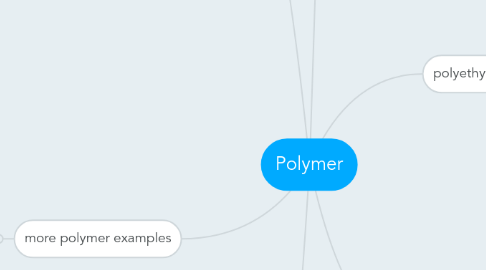
1. POLYMERS IN US
1.1. amino acids
1.2. polysaccharides
2. Polymerization
2.1. What is it?
2.1.1. the process of reacting monomer molecules together in a chemical reaction to form polymer chains
2.1.2. forms stable covalent chemical bonds between the monomers
2.2. Types
2.2.1. condensation polymerization
2.2.1.1. each step of the process is accompanied by the formation of a molecule of some simple compound, often water
2.2.2. addition polymerization
2.2.2.1. monomers react to form a polymer without forming by-products
2.2.2.2. carried out in the presence of catalysts, which in certain cases exert control over structural details that have important effects on the properties of the polymer.
2.3. Polymerization of ethene
2.3.1. under high pressure, double bonds break and remaining molecules bond to form long polymer
3. types
3.1. Linear polymer
3.1.1. made up of chainlike molecules
3.1.2. may dissolve in certain liquids
3.1.3. may soften or melt upon heating.
3.2. Cross-linked polymer
3.2.1. molecular structure is a network ( thermosetting resins)
3.2.2. form under the influence of heat but, once formed, do not melt or soften upon reheating
3.2.3. do not dissolve in solvents
4. more polymer examples
4.1. polypropene
4.1.1. Properties
4.1.1.1. [CH2CHCH3]n
4.1.1.2. strong, resistant to temperature
4.1.1.3. resistant to fatigue
4.1.1.4. one of the lightest thermoplastics (density 0.905 g cm-3)
4.1.1.5. melting point of 167 degrees celsius
4.1.1.6. (unlike polyethene) transparent.
4.1.2. used in plastic hinges, medical equipment, pipes, kitchen ware, containers, bottles, textiles,
4.1.3. Structure
4.1.3.1. depends on the position of the methyl groups
4.1.3.1.1. stereoregular
4.1.3.1.2. atactic
4.2. BOTH PRODUCED BY ADDITION POYLMERIZATION
4.3. polychloroethene
4.3.1. [CH2CHCl]n
4.3.2. used in pipes, signs, clothing, packaging, plastic PVC windows and doors
4.3.3. Properties
4.3.3.1. most versatile plastic
4.3.3.2. can have different molecular masses and therefore can range from rigid to flexible
4.3.4. 2nd most widely used (after polyethene)
4.3.5. Manufacture
4.3.5.1. 1. ethene is converted into 1,2-dichloroethane 2. 1,2-dichloroethane is cracked to chloroethene (vinyl chloride) 3. polymerization of chloroethene (vinyl chloride)

